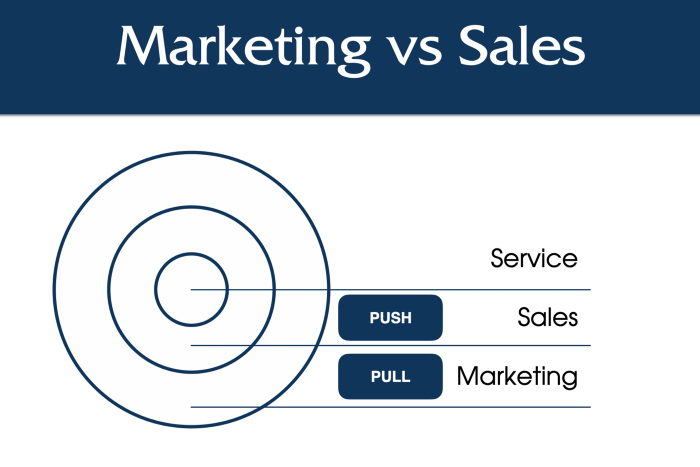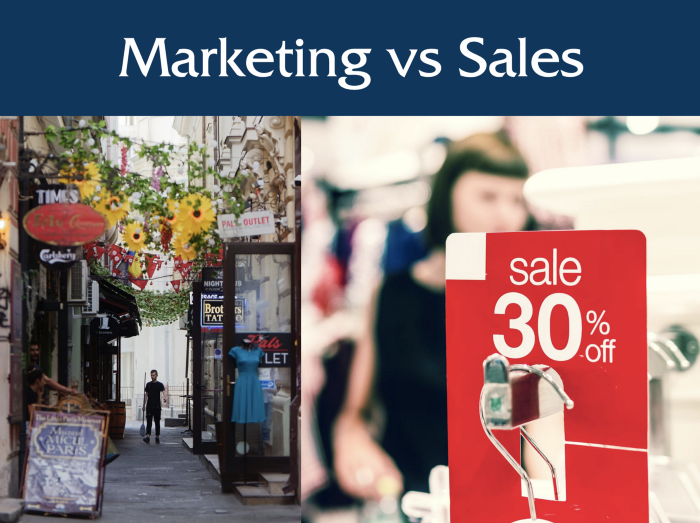Sales gets you where you want to go. Marketing is why you want to get there.

Meme by Alex Bogusky
Does selling feel sleazy to you? If so, there’s a good chance you don’t understand the difference between sales and marketing.
Using the example above, these two signs give you very different reactions.
In the split-second that you see the hitchhiker, you make a flash decision whether to pull over. That immediate reaction matters. Selling and marketing will give you very different results.
The first sign will tell you where the hitchhiker is going. If you happen to be going to Jacksonville, and this guy is going to Jacksonville, there is alignment— but it’s up to you to decide if you want to pick him up.
The second sign tells you why he’s hitchhiking. His destination doesn’t actually factor into your decision. You could be going somewhere completely different, and decide to pick him up anyways if you support his mission.
The Difference Between Sales and Marketing
Sales and Marketing are as different as pushing and pulling.
Sales only feels pushy if you haven’t done enough pulling.
3 Phases of the Customer Journey: Marketing, Sales, and Service
We can look at the three phases of becoming a customer like the fertilization of an egg. You have to go through the outer circles before you can penetrate the inner circles.

Service is only given to customers that have already paid you money. When somebody pays you, you no longer have to sell to them. You service them.
The inner dividing line — the line between the circle of service, and the circle of sales — is represented by the financial transaction.
(Yes, you can up-sell or cross-sell current customers. But you no longer have to convince them that you are trustworthy and reputable. They have been sold on doing business with you.)
There’s a similar boundary between sales and marketing. If you try selling to somebody before they complete the marketing phase, before they voluntarily decide to come closer, that’s when sales feels pushy.
Marketing pulls people closer to you.
Marketing is what happens on the outside of a shop window. Shopkeepers will entice window shoppers by setting up a nice storefront. If it’s appealing, you will enter the store and come inside.
Once you cross the threshold and enter the store, it’s fair game for a shopkeeper to notice you pick up an item on a shelf. If they come up to you and ask, “Would you like to buy that?” it’s not pushy at all. You are in their store, looking at an item, and considering whether you want to buy it. Sales is fair game, inside the shop.

It’s not the right time to enter a selling conversation when someone is still outside the shop, before they have decided to go inside.
Have you ever had this happen? Maybe you’ve been in a crowded pedestrian mall, and somebody come up to you and said, “Hey, come in my shop over there and buy something.” That feels pushy, because you haven’t volunteered to enter their shop.
The work of marketing is to get people to enter your shop.
When Sales and Marketing Conflict
I was once a sales manager for a large international organization, helping a team of dozens of sales reps by designing their sales proposals. They sold complicated services to large governmental organizations. We created detailed 60-page proposals describing their problems and our solutions.
The difficulty with this job was that there wasn’t a strong alignment with the marketing department. The Customer Journey lived with marketing. So, the leads were nurtured (and the relationships were nurtured) in the marketing department.
By the time a lead was handed over to sales, they had little understanding of who the client was, or what they needed.
So we patched together proposals that we thought made sense. Sometimes it worked, and sometimes leads told us that our proposal did not match what the marketing team promised.
Ideally, you want relationships to be nurtured through marketing and into sales. When they go through the transaction, then you can finally deliver service. It’s important to acknowledge that each of these phases is different.
How can Sales and Marketing work together?
According to a report by Aberdeen, companies that have an alignment between marketing and sales have a 20% annual growth rate. Compare this to the 4% decline seen with companies who struggle, and you’ll understand why it’s important to get them working together.

Photo by Romanen on Pixabay
Sales is the dancer, while Marketing is the choreographer.
Your marketing department choreographs the moves of your salespeople. It’s the salespeople that actually execute those moves on stage.
The transaction (and the decision to make it) happens in the performance. But the quality of the choreography can help or hinder the closing ratio.
Salespeople practice their moves repeatedly, like a dancer. This enables them to sell better during the actual performance with a live prospect.
If a dancer gets on stage without working with a choreographer first, they can move. It can be interesting, but it is rarely compelling. The best dancers work with experts who understand what the audience wants to see.
Dancing without a choreographer is like moving directly into sales without any marketing. It’s not going to be an intentional performance, the audience isn’t really going to like it, and you’re not going to make very good sales.
Are Sales and Marketing the same?
Seth Godin likes to say that an interruption marketer is a hunter, while a permission marketer is a farmer.
This difference between hunting and farming is well known in sales communities. Some salespeople are hunters, who you go and seek out the deals. Others are farmers, who nurture relationships with people that eventually grow into deals.
Marketing is farming leads, and Sales is hunting leads.
Regardless of your department or your job title, anyone can shepherd a customer through their journey. You just need to know when to push, and when to pull.

If someone is in the outer circle, you can market to them, but don’t sell to them. Yet.
Identify the transition from marketing into sales. What is the specific step in the Customer Journey where someone signals they are ready to have a sales conversation?
Focus your marketing efforts on encouraging people to take that step.
The Transition from Marketing to Sales is Voluntary
For my digital marketing agency, my transition happens when someone requests a consultation. I can market to my audience all day long, and make offers in an offhand way, but I don’t sell to my audience at large. I only sell to people who put up their hand and say, ‘I’d like your advice on my business.’
After I spend some time brainstorming with them, I make an offer. Then I use my selling skills to sell that offer.
If I tried to sell my services before people completed the first 3 stages of the Marketing Cycle (“Know, Like, and Trust”), then selling would feel sleazy.
But when you pull people to you through marketing, sales is a natural push.
3 Steps To Transition from Marketing to Sales
- Start by selling your why. Convince people, through marketing, of the value of your mission.
- Identify when a customer moves from Marketing to Sales. When do they voluntarily take an action that declares they are ready for a selling conversation?
- Use your marketing to encourage people to take that action. Don’t use your marketing to sell, it’s pushy. Use your marketing to pull, and only push when they are ready.
What can you do next with your marketing? Focus on encouraging the one action that makes customers ready for sales conversations.
This article is an excerpt from my book, ‘Marketing Yourself.’ You can read the whole book here.




![Educate yourself before AI educates you [Now Enrolling – AI-Powered Professionals]](https://caelanhuntress.com/wp-content/uploads/2025/04/educate-yourself-featured-500x383.png)
Leave A Comment